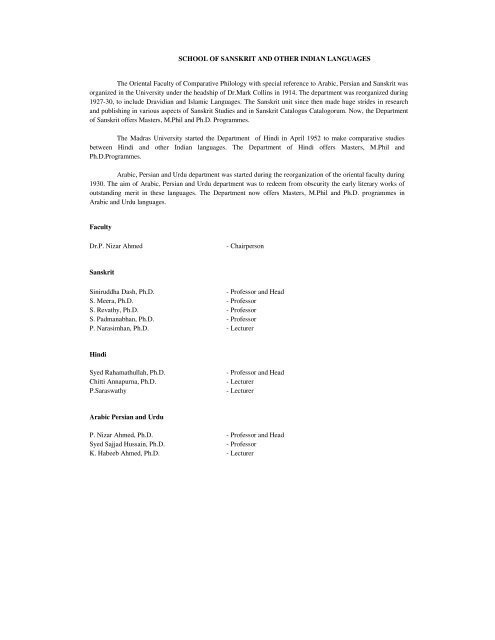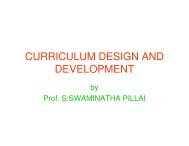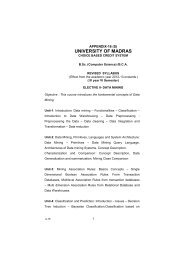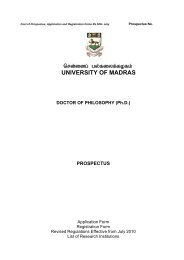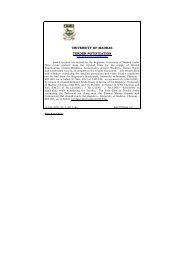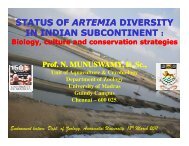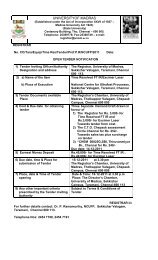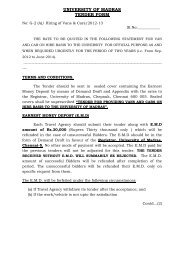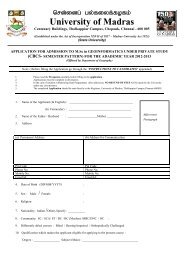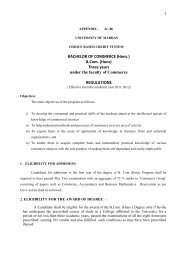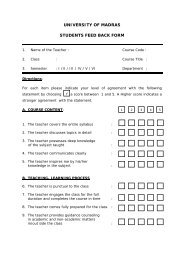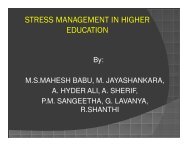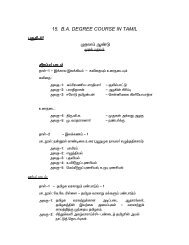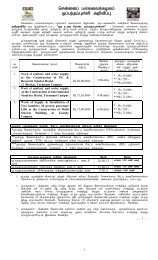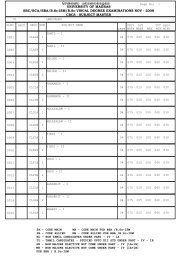School of Sanskrit and other Indian Languages - University of Madras
School of Sanskrit and other Indian Languages - University of Madras
School of Sanskrit and other Indian Languages - University of Madras
Create successful ePaper yourself
Turn your PDF publications into a flip-book with our unique Google optimized e-Paper software.
exerted its influence on many <strong>other</strong> schools <strong>of</strong> thought. Hence this course is <strong>of</strong>fered on the Sankhya school, sincea good grounding in this system is required for a better grasp <strong>of</strong> many <strong>other</strong> systems.Karika.General Introduction to <strong>Indian</strong> Darsana-s, Introduction to Sankhya Doctrine, Study <strong>of</strong> the Text Sankhya-SIL C112 The Karaka Theory (C) 4 0 0 4 Dr. P. NarasimhanCourse ObjectivesThe Karaka theory is one <strong>of</strong> the greatest contributions <strong>of</strong> Samskrit Grammar to language studies. It isone <strong>of</strong> the vital theories <strong>of</strong> Panini, which is universally applicable in the study <strong>of</strong> relations between nouns <strong>and</strong>verbs. Case markers <strong>of</strong> nominal stems are representatives <strong>of</strong> underlying karaka-s, which have been logicallydefined by Panini. A thorough underst<strong>and</strong>ing <strong>of</strong> the concept is a prerequisite for a proper appreciation <strong>of</strong> thefunctioning <strong>of</strong> a language. Hence this course aims at providing a good grounding in this area <strong>of</strong> syntax <strong>and</strong>Semantics.Unit I : The Concept <strong>of</strong> Karaka, the Karma-karakaUnit II : The karana <strong>and</strong> kartr-karaka-sUnit III : The sampradana-karakaUnit IV : The apadana-karakaUnit V : The Sasti-vibhakti <strong>and</strong> adhikarana-karaka, Recapitulation.SIL E106 Kathopanisad (E) 3 0 0 3 Dr. S. RevathyCovering the entire field <strong>of</strong> Vedanta, the nature <strong>of</strong> the ultimate Being as well as the yogic sadhana, thisUpanisad has the additional appeal <strong>of</strong> the poetic setting wherein the elderly father Vajasravas devoted to a lowersacrificial path <strong>of</strong> karma is contrasted with his young son Naciketas, curious to know about the higher path <strong>of</strong>knowledge <strong>of</strong> the knowledge <strong>of</strong> the ultimate Reality <strong>and</strong> the higher path <strong>of</strong> knowledge <strong>of</strong> the ultimate Reality <strong>and</strong>the secret <strong>of</strong> what happens after death, which the God <strong>of</strong> death (Yama) himself is made to reveal.SIL E107 Visistadvaita Metaphysics (E) 3 0 0 3 Dr. S. PadmanabhanCourse ObjectivesIndia has a glorious philosophical tradition, dotted by celebrated luminaries in all schools. One <strong>of</strong> themost powerful writers among them is Sri Yamuna, who was the gr<strong>and</strong> preceptor <strong>of</strong> Ramanuja, who also paved theway for Ramanuja to formulate his school <strong>of</strong> thought <strong>and</strong> establish it on a firm ground. His writings at onceprovide pr<strong>of</strong>ound philosophical insights <strong>and</strong> high literary delight. -Like Yamuna, Ramanuja is an<strong>other</strong> great writer,whose Vedarthasangraha is an equally important text, dealing with the basics <strong>of</strong> his philosophical thought. It isacclaimed for its lucidity, depth <strong>and</strong> ornate style. This course is <strong>of</strong>fered to introduce the students to themetaphysical edifice <strong>of</strong> Ramanuja’s school, through one <strong>of</strong> these two treatises – the Siddhitraya orVedarthasangraha.Unit I : Introduction to the author <strong>and</strong> his worksUnit II :Unit III : Study <strong>of</strong> the TextUnit IV :Unit V : Resume <strong>and</strong> Evaluation.SIL E108 Mimamsa (E) 3 0 0 3 Dr. P. NarasimhanMimamsa is one <strong>of</strong> the six systems <strong>of</strong> <strong>Indian</strong> Philosophy. It provides great insights into how ourancients exercised their minds in the field <strong>of</strong> exegetics. This course is <strong>of</strong>fered with the objective <strong>of</strong> acquinting thestudents in this field <strong>of</strong> study. Depending upon the level <strong>of</strong> accomplishment <strong>of</strong> the students, one <strong>of</strong> the texts, eitherMimamsaparibhasa or Arthasangraha is <strong>of</strong>fered.Mimamsaparibhasa or Arthasangraha.with commentariesSIL E109 History <strong>of</strong> Samskrit Poetics (E) 2 1 0 3 Dr. Meera SarmaCourse Objectivesauthors.Theories <strong>of</strong> causes <strong>of</strong> beauty from the first century AD to 16 th century AD. Important works <strong>and</strong>
SIL C113 The Theory <strong>of</strong> Compounding (Samasa (C) 3 0 0 3 Dr. P. NarasimhanCourse ObjectivesCompounding <strong>of</strong> words is not a feature special to any particular language, but Samskrit language isreplete with samasas. Writers use various varieties <strong>of</strong> samasas for expressing their ideas <strong>and</strong> concepts <strong>and</strong> thelanguage uniquely provides high flexibility for compounding, <strong>and</strong> great scope for de-compounding in more waysthan one. For a proper underst<strong>and</strong>ing <strong>and</strong> appreciation <strong>of</strong> Samskrit language a sound knowledge <strong>of</strong> samasas isessential. Hence this course aims at providing the requisite knowledge about the concept <strong>of</strong> samsa, its varieties<strong>and</strong> usages.The Samasaprakarana <strong>of</strong> the Siddhantakaumudi.SIL C114 Early Texts (Niruktam) (C) 3 0 0 3 Guest FacultyCourse ObjectivesNiruktam is one <strong>of</strong> the very early texts available that attempts to provide insights into the etymology <strong>and</strong>derivation <strong>of</strong> words.SIL E110 Vedantaparibhasa (E) 3 0 0 3 Dr. S. RevathyStudents who have already got introduced to the Epistemology <strong>of</strong> Advaita by the study <strong>of</strong> the pramanasection <strong>of</strong> this text could pursue reading these two sections <strong>of</strong> this text to acquire a clear underst<strong>and</strong>ing <strong>of</strong> theconcepts <strong>of</strong> Advaitya Vedanta.SIL E111 Vedantadipa (E) 3 0 0 3 Dr. S. PadmanabhanCourse ObjectivesOrthodox <strong>Indian</strong> Philosophical thought is dominated by three vital texts called Prasthanatraya. One <strong>of</strong>them is the Bramasutra. Celebrated commentaries have been written on it by great acharyas. The Vedanta Dipa isa concise commentary on it by Ramanuja. This course aims at providing a study <strong>of</strong> the same.The fourth chapter <strong>of</strong> the text Vedanta Dipa.SIL E112 The Krtya section <strong>of</strong> Krt-pratyayas (E) 3 0 0 3 Dr. P. NarasimhanCourse ObjectivesThis is a very important section, which provides light on krtya-pratyayas <strong>of</strong> krdanta section, which dealswith nominal derivations from verbal roots, a plethora <strong>of</strong> which is found in Samskrit Language. Hence a study <strong>of</strong>this small section will pave way for the underst<strong>and</strong>ing <strong>of</strong> innumerable forms.The Krtya section <strong>of</strong> Krt-pratyayas from the Vaiyakarana-siddhanta-kaumudi.SIL E113 The Paspasahnika <strong>of</strong> Mahabhasya (E) 3 0 0 3 Dr. S. DashCourse ObjectivesThe Mahabhasya <strong>of</strong> Patanjali is considered to be an outst<strong>and</strong>ing monument <strong>of</strong> among grammar treatises.It is a brilliant exposition <strong>of</strong> the varttikas <strong>and</strong> in turn, the sutras. Traditionally the study <strong>of</strong> the Paspasahnika isconsidered to be indispensable for commencing an advanced study <strong>of</strong> grammar. This course aims at introducingthis important text to students.SIL E114 Theory <strong>of</strong> Sphota (E) 3 0 0 3 Dr. S. DashCourse ObjectivesThe Sphota theory highlights the relationship between the word <strong>and</strong> the world. It holds that there iseternal relationship between the word <strong>and</strong> meaning. It hypothesizes that sphota is the ultimate sound, from whichthe whole language is developed, through different prakriya-s. Lastly human knowledge gets manifested indifferent forms <strong>of</strong> sounds (varna-sphota), words (pada-sphota) <strong>and</strong> sentences (vakya-sphota).Unit I : Sound <strong>and</strong> time as the ultimate reality,Unit II : Study <strong>of</strong> grammar as the means for salvationUnit III : Concept <strong>and</strong> Definition <strong>of</strong> Sphota,Unit IV : Relation between Sphota <strong>and</strong> DhvaniUnit V : Relation between Word <strong>and</strong> Meaning.
SIL C201 Grammar I (C) 4 0 0 4 Dr. P. NarasimhanStudy <strong>of</strong> grammar is indispensable for higher studies <strong>of</strong> Samskrit Language. Hence this course isintended to introduce the students to a st<strong>and</strong>ard text on Samskrit Grammar, which commences from the basics <strong>and</strong>goes up, being a brilliant commentary on Panini’s Astadhyayi.Unit I : SamjnaprakaranamUnit II : ParibhasaprakaranamUnit III : Acs<strong>and</strong>hiprakaranamUnit IV : Prakrtibhavas<strong>and</strong>hiprakaranamUnitV : Hals<strong>and</strong>hiprakaranamSIL C201 Introduction to <strong>Indian</strong> Logic (C) 4 0 0 4 Dr. S. Revathy*Among the numerous systems <strong>of</strong> philosophy that have been evolved in India during the last threethous<strong>and</strong> years, the Nyaya <strong>and</strong> Vaisesika occupy a unique position on account <strong>of</strong> their cardinal doctrines. Every<strong>other</strong> system accepts the fundamental principles <strong>of</strong> Nyaya logic <strong>and</strong> borrows the phraseology <strong>of</strong> the Nyaya for theirpurpose. The objective <strong>of</strong> this course is therefore to introduce the students to the system <strong>of</strong> Nyaya <strong>and</strong> Vaisesikato have a clear underst<strong>and</strong>ing <strong>of</strong> the <strong>other</strong> systems <strong>of</strong> philosophy.Unit I : Introduction to Orthodox <strong>and</strong> Heterodox systemsUnit II : Introduction to Nyaya <strong>and</strong> Vaisesika literatureUnit III : The Text Tarkasangraha <strong>and</strong> its commentaries. Importance <strong>of</strong> the commentary NyayabodhiniUnit IV : Study <strong>of</strong> the text TarkasangrahaUnit V : Study <strong>of</strong> the text NyayabodhiniSIL C203 Principles <strong>of</strong> <strong>Indian</strong> Astronomy <strong>and</strong> Mathematics I (C) 4 0 0 4 Guest FacultyUnit I : Introduction to <strong>Indian</strong> Astronomy And MathematicsUnit II : A survey <strong>of</strong> the literature available.Unit III : Principles.SIL E201 Introduction to <strong>Sanskrit</strong> I (E) 3 0 0 3 Any FacultyCourse ObjectivesSamskrit Language has a unique place among the Indo-European languages. Its beautiful structure hasbeen acknowledged worldwide. Knowledge <strong>of</strong> Samskrit will lead one to read <strong>and</strong> underst<strong>and</strong> the vast literature invarious subjects, which speak <strong>of</strong> our ancient culture <strong>and</strong> heritage. Hence this course aims at acquainting thestudents with the basics <strong>of</strong> Samskrit Language.1. First twelve lessons from the book Infant Reader.2. Twenty st<strong>and</strong>ard SubhashitasSIL E202 Raghuvamsa (E) 3 0 0 3 Guest FacultyCourse ObjectivesThis is one <strong>of</strong> the most important Mahakavyas <strong>of</strong> Kalidasa, which is at once simple <strong>and</strong> elegant. Study<strong>of</strong> kavyas in a language is meant to provide sufficient expertise in the language <strong>and</strong> it is specially so for Samskrit,where one learns the nuances <strong>of</strong> the usages <strong>of</strong> the language through the study <strong>of</strong> kavyas. Further the traditionalway <strong>of</strong> imparting basics as well as advanced knowledge <strong>of</strong> Samskrit has been through a study <strong>of</strong> the panca-mahakavyas.Hence this course aims at providing the much needed, pr<strong>of</strong>iciency through a study <strong>of</strong> this important text.SIL C204 Introduction to Linguistics (C) 4 0 0 4 Dr. S. DashCourse ObjectivesLinguistics is a new branch <strong>of</strong> language study. It <strong>of</strong>fers newer <strong>and</strong> newer insights into the underst<strong>and</strong>ing<strong>of</strong> language functioning. There are language-free <strong>and</strong> language-specific aspects, found among languages.Linguistics facilitates in sifting these aspects <strong>and</strong> knowing them. It not only helps one to know about one’s ownlanguage but also about <strong>other</strong> languages known to him/her. The knowledge <strong>of</strong> linguistics is very essential in amulti-lingual society like ours. It starts from a study <strong>of</strong> basic sound units <strong>of</strong> a language <strong>and</strong> makes an in depthstudy at various levels like word level study called morphology, etc., which ultimately provide deep knowledge
about the functional aspects <strong>of</strong> languages. Since language study without Linguistics will be incomplete, this courseaims ay providing a comprehensive knowledge about the basics <strong>of</strong> Linguistics.Unit I : Introduction to language as a medium <strong>of</strong> communication, Definition <strong>of</strong> language, Language types,Dialects, StdDialects, Idiolects, etc..Unit II : Phonetics – Articulatory Phonetics, etc., Air Stream Mechanism, Process <strong>of</strong> Articulation, Place <strong>of</strong>Articulation, Manner <strong>of</strong>classification <strong>of</strong> sounds.Unit III : Phonology – Phone, Phoneme <strong>and</strong> AllophoneUnit IV : Morphology – Morph, Morpheme <strong>and</strong> Allomorphs, Classification <strong>of</strong> Morphemes.Unit V : Syntax <strong>and</strong> Semantics - Definition <strong>of</strong> Sentence, Immediate Constituents Analysis, Phrase StructureGrammar, UniversalGrammar, etc., SDefinition <strong>of</strong> Meaning, Types <strong>of</strong> Meanings, Word Meaning <strong>and</strong> Sentence Meaning.SIL C205 Introduction to Ayurveda (C) 3 0 0 3 Guest FacultyUnit I : Introduction to Traditional Medical Systems .Unit II : History <strong>of</strong> <strong>Indian</strong> Medical systems.Unit III : Principles <strong>of</strong> AyurvedaSIL C206 Introduction to Yoga (C) 3 0 0 3 Guest FacultyUnit I : Introduction to Yoga PhilosophyUnit II : History <strong>of</strong> YogaUnit III : Principles <strong>of</strong> YogasastraSIL C207 Architecture I (C) 3 0 0 3 Guest FacultyCourse ObjectivesArchitecture is the harmonious combination <strong>of</strong> form , function <strong>and</strong> construction that leads to a pleasantliving environment (sattvika). It is defined as the science <strong>of</strong> design <strong>and</strong> construction <strong>of</strong> buildings. Thus the core <strong>of</strong>architecture is the theory <strong>of</strong> beauty <strong>and</strong> truth. This concept is dealt with in the case <strong>of</strong> India’s architecture, theVaastu Sastra in a holistic manner.Unit I : Introduction to <strong>Indian</strong> ArchitectureUnit II : Components <strong>of</strong> VastusastraUnit III : Aesthetic quality <strong>of</strong> VastuvidyaSIL E203 Introduction to Samskrit - II (E) 3 0 0 3 Any FaculyPrerequisteCompletion <strong>of</strong> the earlier course (I) or sufficient knowledge <strong>of</strong> Samskrit language.Course ObjectivesThis is a continuation <strong>of</strong> the earlier course <strong>and</strong> aims at strengthening the knowledge <strong>of</strong> Samskrit gainedfrom the earlier course (I).1. Lessons thirteen to twenty from the book Infant Reader.2. Twenty st<strong>and</strong>ard SubhashitasSIL E204 Grammar IA (E) 4 0 0 4 Dr. P. NarasimhanStudy <strong>of</strong> grammar is indispensable for higher studies <strong>of</strong> Samskrit Language. Hence this course isintended to introduce the students to a st<strong>and</strong>ard text on Samskrit Grammar, which commences from the basics <strong>and</strong>goes up, being a brilliant commentary on Panini’s Astadhyayi. And this is a continuation <strong>of</strong> the s<strong>and</strong>hi sectionfrom the previous semester.Svaadi <strong>and</strong> Visargas-s<strong>and</strong>hi sections <strong>of</strong> Siddhantakaumudi.SIL C208 Agamas (C) 4 0 0 4 Dr. S. PadmanabhanUnit I : Introduction to Agamas, DefinitionUnit II : Principles <strong>of</strong> Agamas, Classification <strong>of</strong> AgamasUnit III : Vaisnava & Saiva Agamas - Their Doctrines
SIL C209 Ayurveda (C) 4 0 0 4 Guest FacultySelect portions from AstangahrdayaSIL C210 Yoga (C) 4 0 0 4 Guest FacultySelect portions <strong>of</strong> HathayogapradipikaSIL C211 <strong>Indian</strong> Astronomy II (C) 4 0 0 4 Guest FacultySome key concepts based on important texts are to be studiedSIL E205 Systems <strong>of</strong> <strong>Indian</strong> Philosophy (E) 3 0 0 3 Dr. S. RevathyReference Text: Sarvadarsan Sangraha <strong>of</strong> MadhavacharyaSIL E206 Grammar II (The Karaka Theory) (E) 3 0 0 3 Dr. P. NarasimhanCourse ObjectivesThe Karaka theory is one <strong>of</strong> the greatest contributions <strong>of</strong> Samskrit Grammar to language studies. It isone <strong>of</strong> the vital theories <strong>of</strong> Panini, which is universally applicable in the study <strong>of</strong> relations between nouns <strong>and</strong>verbs. Case markers <strong>of</strong> nominal stems are representatives <strong>of</strong> underlying karaka-s, which have been logicallydefined by Panini. A thorough underst<strong>and</strong>ing <strong>of</strong> the concept is a prerequisite for a proper appreciation <strong>of</strong> thefunctioning <strong>of</strong> a language. Hence this course aims at providing a good grounding in this area <strong>of</strong> syntax <strong>and</strong>Semantics.Unit I : The Concept <strong>of</strong> Karaka, the Karma-karakaUnit II : The karana <strong>and</strong> kartr-karaka-sUnit III : The sampradana-karakaUnit IV : The apadana-karakaUnit V : The adhikarana-karaka, Recapitulation.SIL C212 <strong>Indian</strong> Fine Arts I (C) 4 0 0 4 Guest FacultyUnit IUnit II: Introduction to Classical <strong>Sanskrit</strong> Literature: Dramuturgy - Natyasastra (Chapter VI)SIL C213 <strong>Indian</strong> Fine Arts Music - II (C) 3 0 0 3 Guest FacultyBhakti songs – Compositions <strong>of</strong> great MusiciansUnit IUnit II: Bhakti Songs in Samskrit. Bhajana Tradition - Todaya Mangalam, Songs <strong>of</strong> Bodhendra, SadguruSvami, SadasivaBrahmendra.Songs expressing nava-vidha-bhakti, navavarna <strong>and</strong> navagraha themes.: Style <strong>of</strong> Samskrta in Kriti compositions, Songs <strong>of</strong> Muttusvami Dikshitar, Svati Tirunal <strong>and</strong> <strong>other</strong>composers. 20 thcentury composers <strong>of</strong> songs in Samskrta.Kulaka <strong>and</strong> chedyaka forms in songs. Usage <strong>of</strong> variousvibhakti-s <strong>and</strong> samasas.Aspects <strong>of</strong> phonetics –usage <strong>of</strong>aspirated <strong>and</strong> conjuct consonants in musical compositions.Unit III : Metre <strong>and</strong> <strong>other</strong> prosodical element in musical compositions. Study <strong>of</strong> the work “Muhana-prasaantyaprasa vyavastha”<strong>of</strong> Svati Tirunal .Unit IV : Musical Drama in Samskrta. General study <strong>of</strong> Gita –Govinda <strong>and</strong> Sri Krsna lila-tarangini <strong>of</strong> NarayanaTirtha.Unit V:Biographical works <strong>of</strong> composers inSamskrta. Srityagaraja-caritram, Sri Tyagaraja-vijaya-kavya,Srimuttusvamidikshitacaritam-mahkavyam.SIL C214 Architecture II (C) 4 0 0 4 Guest FacultyCourse ObjectivesDifferent kinds <strong>of</strong> Architecture with reference to important texts. Introduction to Devalayavastu,Manusyalayavastu, Citravastu, Nagaravastu, Durgavastu.
SIL E207 Principles <strong>of</strong> Management (E) 3 0 0 3 Guest FacultyUnit I : IntroductionUnit II : Important TextsUnit III : Study <strong>of</strong> some select portions.SIL E208 The Theory <strong>of</strong> Compounding (Samasa (C) 3 0 0 3 Dr. P. NarasimhanCourse ObjectivesCompounding <strong>of</strong> words is not a feature special to any particular language, but Samskrit language isreplete with samasas. Writers use various varieties <strong>of</strong> samasas for expressing their ideas <strong>and</strong> concepts <strong>and</strong> thelanguage uniquely provides high flexibility for compounding, <strong>and</strong> great scope for de-compounding in more waysthan one. For a proper underst<strong>and</strong>ing <strong>and</strong> appreciation <strong>of</strong> Samskrit language a sound knowledge <strong>of</strong> samasas isessential. Hence this course aims at providing the requisite knowledge about the concept <strong>of</strong> samsa, its varieties<strong>and</strong> usages.M.A. HINDISubjectCodeThe Samasaprakarana <strong>of</strong> the Siddhantakaumudi.IV SEMESTERTitle <strong>of</strong> the CourseC /ECreditsL T P CSIL C001 Modern Prose C 3 1 0 4SIL C002 Drama <strong>and</strong> One Act Plays C 3 1 0 4SIL C003 History <strong>of</strong> Hindi Literature C 2 1 0 3SIL E001 Translation : Theory <strong>and</strong> Practice E 2 1 0 3SIL E002 Journal Writing Practices E 2 1 0 3II SEMESTERSIL C004 Modern Poetry C 3 1 0 4SIL C005 General Linguistics C 3 1 0 4SIL C006 History <strong>of</strong> Hindi Language C 2 1 0 3SIL E003 Official Language Policy <strong>of</strong> Government <strong>of</strong> India E 2 1 0 3SIL E004 Commercial <strong>and</strong> Business Correspondence E 2 1 0 3III SEMESTERSIL C007 Ancient Poetry C 3 1 0 4SIL C008 Medieval Poetry C 3 1 0 4SIL C009 <strong>Indian</strong> Poetics C 2 1 0 3SIL E005 Practical Grammar <strong>of</strong> Hindi <strong>and</strong> Conversational Hindi E 2 1 0 3SIL E006 Publication Writing Practices E 2 1 0 3IV SEMESTERSIL C010 Western Poetics C 3 1 0 4SIL C011 Literary Biographical Studies : Prem Ch<strong>and</strong> C 3 1 0 4SIL C012 Noting <strong>and</strong> Drafting C 3 1 0 4SIL C013 Essay Writing C 2 1 0 3SIL C014 Dissertation C 0 1 5 6SIL S001 Introduction <strong>of</strong> Hindi Language S S 2 1 3SIL S002 Spoken Hindi S S 2 1 3
SIL C001 Modern Prose 3 1 0 4 Syed RahmathullahThis paper would throw light on the development <strong>of</strong> the Hindi Literature during the present century (i.esince 1900) <strong>and</strong> hence called “Modern Prose”, which is combination <strong>of</strong> social reformation, cultural movements,national struggle for Independence, social equality, <strong>and</strong> social justice etc. This paper would enhance theknowledge <strong>of</strong> these impacts, <strong>and</strong> thereby inculcate the “ideal citizenship”.SIL C002 Drama <strong>and</strong> One Act Plays 3 1 0 4 Ch. AnnapurnaThis course would help the students to gain knowledge <strong>of</strong> <strong>Indian</strong> history, patriotism, culture <strong>and</strong>contemporary social problems such as dowry, status <strong>of</strong> women in society <strong>and</strong> political problems. This coursewould also help the student to distinguish between dramas <strong>and</strong> one act plays.SIL C003 History <strong>of</strong> Hindi Literature 3 1 0 4 Syed RahamathullahThis paper portrays the different stages in the development <strong>of</strong> Hindi literature over the past 1000 years.The entire history is brought under four periods viz, Old <strong>and</strong> Medieval, Bhakthi, Reethi <strong>and</strong> Modern <strong>and</strong> theirrespective literatures.SIL E001 Translation : Theory & Practise 2 1 0 3 Ch. AnnapurnaThis course <strong>of</strong>fers an exhaustive theoretical account <strong>of</strong> translation methods.SIL E002 Journal writing practice 1 1 0 2 Syed RahmathullahThis Course <strong>of</strong>fers an exhaustive Theoretical knowledge <strong>and</strong> Practical Methods <strong>of</strong> writing journalsSIL C004 Modern Poetry 3 1 0 4 Ch. AnnapurnaThrough this course, the students will know old <strong>and</strong> new poetry. More light will be thrown on newtrends in contemporary poetry. Through this course appreciation <strong>of</strong> poetry <strong>and</strong> taste will be created among thestudents.SIL C005 General Linguistics 3 1 0 4 Ch. AnnapurnaThe Course deals with origin <strong>of</strong> languages, phonetic styles, identities, differences <strong>and</strong> grammar; <strong>and</strong>reveals the strength <strong>of</strong> Hindi language.SIL C006 History <strong>of</strong> Hindi Language 3 1 0 4 Syed RahamathullahThis course gives the historic perspective <strong>of</strong> the origin <strong>and</strong> development <strong>of</strong> the Hindi language.Students would also come to know <strong>of</strong> Aryan <strong>and</strong> Dravidian families <strong>of</strong> languages.SIL E003 Official Language Policy <strong>of</strong> Government <strong>of</strong> India 2 1 0 3 Guest FacultyThis Course sums up the <strong>Indian</strong> Constitutional provisions regarding the <strong>of</strong>ficial language policy <strong>and</strong>efforts <strong>of</strong> overnment <strong>of</strong> India in implementing it. By learning this course, students may get ample jobopportunities at the national level.SIL E004 Commercial <strong>and</strong> Business Correspondence 2 1 0 3 Syed RahamathullahIt is a job oriented Course describing modern business in areas like Import, Export, Banking,Insurance etc.SIL C007 Ancient Poetry 3 1 0 4 Syed RahamathullahThis course explains the structure <strong>of</strong> Hindi poetry in the formative period <strong>and</strong> its significance, alongwith its change <strong>of</strong> forms in later stages.
SIL C008 Medieval Poetry 3 1 0 4 Ch. AnnapurnaMedieval poetry is full <strong>of</strong> Bhakthi literature. This course covers the literary works <strong>of</strong> Kabir (SocialReformer through bhakthi), Malik Mohamed Jaysee, (Sufism), Surdas (krishna Bhakthi) <strong>and</strong> Tulsi Das (RamaBhakthi), who created lasting impact on the <strong>Indian</strong> society.SIL C009 <strong>Indian</strong> Poetics 3 1 0 4 Ch. AnnapurnaThis Course unfolds poetic sensibilities like Alankaras, Rasa, Ch<strong>and</strong>a etc. It also describes thecharacteristics <strong>of</strong> Maha Kaviya <strong>and</strong> Kaviya etc.SILE005 Practical Grammar <strong>of</strong> Hindi <strong>and</strong> Conversational Hindi 2 1 0 3 Guest FacultyIt is a Course on spoken Hindi reflecting the differences in formal <strong>and</strong> informal usages <strong>of</strong> Hindilanguage, designed especially to the advantages <strong>of</strong> Non-Hindi students.SIL E006 Publication writing practices 2 1 0 3 Syed RahamathullahThis course makes an attempt to bring out the origin <strong>and</strong> development <strong>of</strong> journalism in Hindi. It alsothrows light on weeklies, fortnighties, monthlies, quarterlies, half-yearlies <strong>and</strong> annuals, <strong>and</strong> st<strong>and</strong>ard editorialswhich have served to cultivate moral values in the society. It also speaks editorial norms <strong>and</strong> journalistic ethics.SIL C010 Western Poetics 3 1 0 4 Ch. AnnapurnaThis paper attempts to distinguish between <strong>Indian</strong> <strong>and</strong> Western literary differences on Kaviyas, whichplay effective role in the reformation <strong>of</strong> heart <strong>and</strong> thought.SIL C011 Literary Biographical Studies : Prem Ch<strong>and</strong> 3 1 0 4 Ch. AnnapurnaAs a Novelist Prem Ch<strong>and</strong>’s contributions to the Hindi novels are explained in this course. It reflectson the contemporary <strong>Indian</strong> society along with its problems such as class strife.SIL C012 Noting <strong>and</strong> Drafting 3 1 0 4 Syed RahamathullahThe content <strong>of</strong> this Course will focus on administrative notings <strong>and</strong> draftings in Hindi. Hence thiscourse is job oriented.SIL C013 Essay Writing 2 1 0 3 Syed RahamathullahIt plans to add to the general <strong>and</strong> literary knowledge <strong>of</strong> the students. It develops the art <strong>of</strong> writing thatwill help them in getting good jobs.SIL C014 Dissertation 0 1 5 6 Syed RahamathullahDissertation is a valuable part <strong>of</strong> this Masters Programme. The students are required to submit adissertation, the length <strong>of</strong> which will be 50-100 pages, in the fourth semester. Dissertations will be on Hindiequivalents <strong>of</strong> any one <strong>of</strong> south <strong>Indian</strong> languages or English or on an issue <strong>of</strong> usage <strong>of</strong> Hindi in practical life suchas technical, administrative, legal <strong>and</strong> juridical, banking, insurance, evenue sphere etc..A student may also submita dissertation on themes containing Hindi equivalents <strong>of</strong> any one <strong>of</strong> the South <strong>Indian</strong> languages or English.Thelength <strong>of</strong> the dissertation should be between 50 <strong>and</strong> 100 pages.
M.A. ARABICI SEMESTERSubject codeTitle <strong>of</strong> the courseCore/elective/self studyCreditsSIL C301 STUDIES IN GRAMMAR – PAPER – I C 4SIL C302 MODERN PROSE C 4SIL C303 MODERN TAFSEER LITERATURE C 4SIL E301 RHETORIC / PROSODY E 3SIL C304 ARABIC LINGUISTICS C 3SIL S301 ARABIC JOURNALISM OF INDIA S.S 3II SEMESTERSIL C305 HADEETH LITERATURE OF 20 TH CENTURY C 4SIL C306 STUDIES IN GRAMMAR – PAPER – II C 4SIL C307 DRAMA AND NOVEL C 4SIL C308 LITERARY CRITICISM C 3SIL E302MYSTICISM / ARABIC SCHOLARS OF SOUTHINDIAE 3SIL S302 ARAB INDOLOGY S.S 3III SEMESTERSIL C309 CLASSICAL PROSE C 4SIL C310 CLASSICAL POETRY C 4SIL C311SIL E303SIL E304TRANSLATION SKILLS C 4ESSAY WRITING / STUDIES IN JOURNALISM INARAB COUNTRIESCONTEMPRORY ARAB THOUGHT / AREA STUDIES –HISTORY OF SAUDI ARABIA DURING 20 TH CENTURYE 3E 3SIL S303INDO ARAB RELATIONSS.S 3IV SEMESTERSIL C312 STUDY OF SPECIAL AUTHER – IMAM BUKHARI C 4SIL C313SIL C314MODERN POETRYBIOGRAPHY OF EMINENT ARABIC THINKERC 4C 4SIL E305 HISTORY OF EGYPT / HISTORY OF IRAQ E 3SIL E306 ARAB TAMIL E 3
S E M E S T E R – ISIL – C301 Studies in grammar – paper – i 3 1 0 4 Guest facultyBooks Prescribed : Comprehensive Arabic Grammar – (First twenty lessons )by Dr. Syed Karamatullah BahmaniThis paper is meant for teaching Arabic Grammar with Modern Methodological approaches.SIL C302 Modern prose 3 1 0 4 Dr. P. Nisar ahmedBooks Prescribed : An nazrat – Part – 1 by Mustafa Lutfi Al ManfalutiThis is meant for introducing the new trends <strong>and</strong> tendencies in Arabic Prose <strong>of</strong> Modern Period speciallyprevalent in the most modern Arabic country, Arab Republic <strong>of</strong> Egypt.SIL C303 Modern tafseer literature 3 1 0 4 Dr. P. Nisar ahmedBooks Prescribed : Mabahit fi U loom –il-Quran by Manna Al Qattan.This paper is meant for studies in new information about Tafseer Literature Written during 20 th Century.SIL E301 Rhetoric \ prosody 2 1 0 3 Guest facultyBooks Prescribed : Al Balagha Al Wadihah ( Related subject) – by Mustafa Amin <strong>and</strong> Ali AlJarim.This paper is introduced to procure knowledge on a very important subject <strong>of</strong> Literary aspects <strong>of</strong> Arabiclanguage.SIL C304 Arabic linguistics 2 1 0 3 Dr. P. Nisar ahmedBooks Prescribed :Al Iqtirah <strong>of</strong> Jalaluddin Assuyuti edited <strong>and</strong> Published by Dr.P. Nisar Ahmed.SIL S301 Arabic journalism <strong>of</strong> india 2 1 0 3 Dr. P. Nisar ahmed1. Addaee - Monthly - Published by Darul Uloom, Deob<strong>and</strong> (U.P)2. Al’Bath Al Islami - Monthly - Nadwatul Ulama, Lucknow3. Sautul Ummeh - Monthly - Jamia Salfia, Varanasi4. Assahwah Al Islamia - Monthly - Darul Uloom, Hyderabad (A.P)5. Ar Raid - Nadvatul Ulama, Lucknow6. AR risalah (Different Issues) - DelhiSIL C305 Hadeeth literature <strong>of</strong> 20 th century 3 1 0 4 Guest facultyBooks Prescribed : Methodology <strong>of</strong> Hadeeth Literature by Dr. AzmiThis paper meant for acquiring latest information <strong>and</strong> pr<strong>of</strong>ound knowledge about Hadeeth Literature.SIL C306 Studies in grammar –paper - ii 3 1 0 4 Guest facultyBooks Prescribed : Comprehensive Arab Grammar by Dr. Syed Karamathullah Bahmani -lesson No. 21 to lesson No. 40.This paper is the continuation <strong>of</strong> the Paper I under the same title to introduce new methods in teaching<strong>and</strong> learning Arabic Grammar with adequate new examples to learn the modern Arabic Language.SIL C307 Drama <strong>and</strong> novel 3 1 0 4 Dr. P. Nisar ahmedBooks Prescribed : “Baitunnamal“ – by Tawfeeq Al Hakeem (Drama) <strong>and</strong> “Zainab”(Novel) by Mohammed Husain HaikalThis paper is prescribed to teach “Modern Arab thought” reflected in the Arabic Dramas <strong>and</strong> novelcompiled by Arab writers <strong>of</strong> modern times.SIL C308 Literary criticism 2 1 0 3 Dr. P. Nisar ahmedBooks Prescribed : An naqd – Al Adabi by Dr. Ahmed AminThis paper is meant for introducing latest <strong>and</strong> modern literary views <strong>and</strong> movements in the field <strong>of</strong>criticism <strong>and</strong> this is an important subject for the students <strong>of</strong> language <strong>and</strong> literature.SIL E302 Mysticism / arabic scholars <strong>of</strong> south india 2 1 0 3 Dr. P. Nisar ahmedBooks Prescribed : 1. Tasawwuf by Dr. S.W. Ashraf 2. Arabic <strong>and</strong> Persian in Carnatic- By Pr<strong>of</strong>. M.Y. Kokan (Relevant ChaptersThis is an elective paper – students can select any one <strong>of</strong> the above mentioned subjects to acquire someinformation <strong>of</strong> the related subjects.
SIL S302 Arab indology 2 1 0 3 Dr. P. Nisar ahmedBooks Prescribed:1. TAHQIQU MALIL HIND – ABU RAIHAN AL BAIRUNI2. Subhul A’Sha – Al qal qash<strong>and</strong>i3. Futuhul Buldan – Al Baladuri4. Murujuzzahab – Al MasoodiSIL C309 Classical prose 3 1 0 4 Guest facultyBooks Prescribed : “Al Bayan Wattabeen” by Abuothman Al Jahiz – first 10 units fromThis paper is meant for acquiring the knowledge <strong>of</strong> literary style <strong>of</strong> the Arabic Prose <strong>of</strong> classical period.SIL C310 Classical poetry 3 1 0 4 Guest facultyBooks Prescribed : “Qaseedatul Burdah” <strong>of</strong> Allama AlBuseeri <strong>and</strong> Qaseeda Banat Suad <strong>of</strong> Ka’ab Binzuhair.This paper is meant for knowing various trends <strong>and</strong> styles <strong>of</strong> the Arabic Poetry compiled by the eminentPoets <strong>of</strong> classical period which Cultivated the refined spiritual culture among the Arabs.SIL C311 Translation skills 3 1 0 4 Dr. P. Nisar ahmedPassages from Latest News Papers, Magazines, Journals, etc., be given for Translation – from Arabic toEnglish, Tamil or Urdu <strong>and</strong> vice – versa Training be provided for acquiring sufficient Translation skills.SIL E303 Essary writing / studies in arabic journalism 2 1 0 3 Dr. P. Nisar ahmedBooks Prescribed : A’lamun nasr Wash Shir Fil Asril Arabi Al Hadeeth (Vol. – I ) – By M.Y. KokanThis is an elective paper. Students can opt any one <strong>of</strong> the above mentioned subjects – subject training begiven to write essays on social Themes or to learn about journalism with special reference to Arabic Journalism <strong>of</strong>India.Contemporary arab thought / area studies history <strong>of</strong> saudiSIL E304arabia during 20 th 2 1 0 3 Dr. P. Nisar ahmedcenturyBooks Prescribed : 1. Qadatul Fikr – by Dr. Taha Husain – First five subjects2. History <strong>of</strong> Modern Arab Countries - by V. LutskyThis is an supportive course meant for acquiring knowledge in related subjects.SIL S303 Indo arab relations 2 1 0 3 Dr. P. Nisar ahmedBooks Prescribed : 1. HIND ARAB TA – ALLUQAT – By SYED SULAIMAN NADWI2. RIJAL AL HIND WASSIND – By QAZI ATHAR RUBARAK PURISIL C312 Study <strong>of</strong> special author – “imam bukhari” 3 1 0 4 Guest facultyBooks Prescribed : Faizul Bari – A.S. Kashmiri/This paper is meant for the study <strong>of</strong> the contribution <strong>of</strong> great scholars <strong>of</strong> Hadeeth LiteratureSIL C313 Modern poetry 3 1 0 4 Guest facultyBooks Prescribed : Asshawqiat – Vol – I First 15 Poem – by Ahmed Shawqi .This is meant to learn about the new Social <strong>and</strong> Cultural Tendencies Prevalent in the Arabic Poetry <strong>of</strong>Modern times.SILBiography <strong>of</strong> eminent arabic thinker 3 1 0 4 Dr. P. Nisar ahmedC314Books Prescribed : “Al ayyam” vol – I, by Dr. Taha HusainThis paper is meant to peep into the heart <strong>and</strong> mind <strong>of</strong> eminent Arabic Thinkers <strong>of</strong> modern period <strong>and</strong> tolearn about their views about various Literatures, Cultures <strong>and</strong> Civilization etc.,SIL E305 History <strong>of</strong> Egypt / history <strong>of</strong> iraq 2 1 0 3 Dr. P. Nisar ahmedBooks Prescribed : History <strong>of</strong> Modern Arab Countries – by V. Lutsky (Relevant Chapters).This paper is meant for discriminating knowledge on related subjects. This is an elective paper.Students can opt any on e <strong>of</strong> the two subjects.SIL E306 “Arab tamil” 2 1 0 3 Dr. P. Nisar ahmedThis is a supportive course meant for dissemination <strong>of</strong> information about a subject known very little butit is a related subject for students <strong>of</strong> Arabic language <strong>and</strong> Literature <strong>and</strong> will be <strong>of</strong> Interest <strong>of</strong> the students <strong>of</strong> <strong>other</strong>subjects also.
M.A. URDUI SEMESTERSUBJECT CODE TITLE OF THE COURSE C/E/SS CSIL C401 GHASAL AUR NAZM C 4SIL C402 DASTAN AUR NOVEL C 4SIL C403 TARIKH - E - ZABAN WA ADAB - E – URDU C 4SIL C404 PHILOLOGY IN URDU C 3SIL E401 SPECIAL AUTHOR – HALI / ABUL KALAM AZAD E 3SIL S401 URDU LEXICOGRAPHY S.S 3II SEMESTERSIL C405 QASIDA AUR RUBAI C 4SIL C406 AFSANA AUR DRAMA C 4SIL C407 AROOZ AUR ILM-E-BADEE C 4SIL C408 URDU JOURNALISM C 3SIL E402 PERSIAN TEXT E 3SIL S402 CULTURAL HISTORY OF MUSLIMS IN INDIA S.S 3III SEMESTERSIL C409 MATHNAWI AUR MARTHIYA C 4SIL C410 TANQUEED C 4SIL C411 INSHAYIA AUR MAQALA C 4SIL E403 DAKHNI LITERATURE E 3SIL E404 URDU KI ADABI TAHREEKATH E 3SIL S403 HISTORY OF NAWABS OF KARNATICS S.S 3IV SEMESTERSIL C412 QADEEM URDU ADAB C 4SIL C413 LITERARY BIOGRAPHICAL STUDIES C 4SIL C414SIL E405SIL E406TARJUMA AUR MAZMOON C 4URDU POETS OF TAMIL NADU E 3MAKTUTA SHANASI E 3
SIL C401 Ghazal aur nazm 3 1 0 4 Dr. Syed sajjad husainBooks Prescribed : History <strong>of</strong> Modern Arab Countries – by V. Lutsky (Relevant Chapters).Ghazal is the Nucleus <strong>of</strong> Urdu Poetry likewise Nazm is the modern form <strong>of</strong> Urdu poetry which isgaining popularity. Both the forms <strong>of</strong> poetry carries a significant place in Urdu poetry,SIL C402 Dastan aur novel 3 1 0 4 Dr. K. Habeeb ahmedBooks Prescribed : DASTAN – Fasanai Ajaib by Rajab Ali Baig Suroor(Textual study to be restricted to Jan-e-Alam Ka Mulk-e-Zarnigar Ki Talaash Mein Nikalna Tak.Novel – Gowdan by Prem ch<strong>and</strong>)This subject deals with the evolution <strong>of</strong> Urdu Fiction <strong>and</strong> gradual development from Dastan to Novelwhich is a Popular form <strong>of</strong> Prose in recent times.SIL C403 Tarikh - e - zaban wa adab - e – urdu 3 1 0 4 Dr. Syed sajjad husainBooks Prescribed : History <strong>of</strong> Literature in IndiaHistory <strong>of</strong> Urdu Literature in Tamil Nadu with Special reference to Nusrathi, Qurbi, Vali Vellori, Baquer Agah,Qazi Badrud Dowla, Badshah, Dr. Abdul Haq, Shakir Naithi, Abbas, Fort St. George College <strong>and</strong> its services toDakhni Literature.This paper is meant to deal with the History <strong>of</strong> Urdu Language <strong>and</strong> Literature systematically. This is tomake the student to know about the gradual development <strong>of</strong> Urdu Literature until today.SIL C404 Philology in urdu 2 1 0 3 Dr. Syed sajjad husainBooks Prescribed : Hindustani Lisaniyat by Dr. Mohiuddin Qadri Zore.This subject deals with the Origin <strong>of</strong> the languages <strong>and</strong> their taxonomy, with special reference to Urdulanguage. This subject is gaining momentum recent times.SIL E401 Special author – hali / abul kalam azad 3 1 0 4 Dr. Syed sajjad husainThis subject deals with detailed study <strong>of</strong> one personality. It helps the student to plan his study in acomprehensive <strong>and</strong> elaborate manner.SIL S401 Urdu lexicography 2 1 0 3 Dr. K. Habeeb ahmedstudy.Lexic is the basic for any language. It is one <strong>of</strong> the significant branches <strong>of</strong> literature. It is an advancedSIL C405 Qasida aur rubai 3 1 0 4 Dr. Syed sajjad husainBooks Prescribed : Qasida-Sauda, ZauqRubaiyat-MirAnees, Hali, Amjadasida is a classical form <strong>of</strong> Poetry whereas Rubai is written on moral themes. These two forms <strong>of</strong> Poetryare popular <strong>and</strong> significant for a literature student. Though the Qasida has become a extinct form <strong>of</strong> Urdu Poetrybut it has its own historical importance.SIL C406 Afsana aur drama 3 1 0 4 Dr. K. Habeeb ahmedAfsana – Urdu Afsanay by Razia Sajjad ZaheerDrama – Anarkali by Imtiaz Ali Taj.“Afasana” the short stories <strong>and</strong> the “drama” a well celebrated part <strong>of</strong> factious literature are essential forthe student to develop creative skills. Due to the overwhelming response towards Afsana in the contemporaryLiterature, it is very much essential to explore the range <strong>of</strong> short stories.SIL C407 Arooz aur ilm-e-badee 3 1 0 4 Dr. Syed sajjad husainBooks Prescribed : Fan-e-Shairi by Allama Akhlaq Husain Dehelvi Jadeed Ilm-e-Arooz by AbdulMajeed.This subject deals with the technical aspect <strong>of</strong> the Urdu Poetry. It provide the knowledge about thePoetic guidelines <strong>and</strong> the classifications <strong>of</strong> Urdu Poetry. This subject will be helpful to students to become moreskill – oriented.SIL C408 Urdu journalism 2 1 0 3 Dr. K. Habeeb ahmedBooks Prescribed : Sahafat – Fanni wa Irti – Qayi Safar by Dr. Parveen FathimaUrdu Journalism is a very significant branch <strong>of</strong> Urdu Literature, which has immense application value.As in the case <strong>of</strong> <strong>other</strong> languages in Urdu also Journalism is gaining popularity.
SIL E402 Persian text 2 1 0 3 Dr. Syed sajjad husainBooks Prescribed : Prose – Gulistan by Saadi (Chapter 3 <strong>and</strong> 7 only) Poetry – Diwan-c-Hafiz by Hafiz(First ten ghazals Only)Persian is the backbone for Urdu Language. This subject deals with a creamy sample <strong>of</strong> Persian Prose<strong>and</strong> Poetry to enable the student to gain essence <strong>of</strong> knowledge about Persian language.SIL S402 Cultural history <strong>of</strong> muslims in india 3 1 0 4 Dr. K. Habeeb ahmedCulture language <strong>and</strong> Religion are interrelated. It deals with the cultural History <strong>of</strong> <strong>Indian</strong> Muslims withspecial reference to Urdu language. This is <strong>of</strong>fered as supportive course to facilitate the students new to thelanguage.SIL C409 Mathnawi aur marthiya 3 1 0 4 Dr. Syed sajjad husainBooks Prescribed : Mathnawi – Sahrul Bayan by Mir HasanMarthiya – Mir Anees – Namak Khwan – Takallum hai fasahath MeriMirza Dabir-Kista Alam Husain Ke member Ki Aab hai.Mathnawi <strong>and</strong> Marthiya are the two forms <strong>of</strong> classical poetry which are still read widely among the UrduMasses. These two are very essential part <strong>of</strong> Urdu literature. Without knowing these two branches <strong>of</strong> Urdu poetrythe literature remains in complete.SIL C410 Tanqueed 3 1 0 4 Dr. Syed sajjad husainBooks Prescribed : Muqaddama-e-Sher-O-Shairi by HaliUrdu Tanqueed Ka Irthiqa by Ibadat BareilviUrdu Tanqueed Par Ek Nazar by Kaleemuddin AhmedJadeed Urdu Tanqueed, Usool Aur Nazariat by Sharib RadoolviTareqqi Pas<strong>and</strong> Adab by Ali Sardar JaferiTanqueedi Nazariyat by Ihtisham HusainLike in the <strong>other</strong> languages “Tanqueed” which st<strong>and</strong>s for criticism is becoming a very vital branch <strong>of</strong>study. It is part <strong>and</strong> Parcel <strong>of</strong> Literature. This enables the student with critical talents on par with <strong>other</strong> literatures.SIL C411 Inshayia aur maqala 3 1 0 4 Dr. K. Habeeb ahmedBooks Prescribed : Inshayia – Ganjhai Giranmaya by Rasheed Ahmed SiddiquiMaqalat – IfadatThese are the two recently developed essay writings. The subject deals with the technical aspects <strong>of</strong> thetwo important branches <strong>of</strong> Urdu Prose – “Inshayia” is borrowed from western literature where it is reffered as“Light – essay”.SIL E403 Dakhni literature 2 1 0 3 Dr. K. Habeeb ahmed“Deccan is referred to South India Dakhini Literature is the Urdu Literature which took shape inSeventeenth Century in South India <strong>and</strong> there after. It is the Primitive stage <strong>of</strong> the language which st<strong>and</strong>simportance in the evolution <strong>and</strong> development <strong>of</strong> the language.SIL E404 Urdu ki adabi tahreekath 3 1 0 4 Dr. Syed sajjad husainAs in any <strong>other</strong> language in Urdu also many transformations took place. The study <strong>of</strong> theserevolutionary changes in a systematic manner is dealt in this subject.SIL S403 History <strong>of</strong> nawabs <strong>of</strong> carnatic 2 1 0 3 Dr. K. Habeeb ahmedBooks Prescribed : Arabic, Persian in Carnatic by Md. Yousuf KokanSources <strong>of</strong> the Nawabs <strong>of</strong> Carnatic By Dr. Md. Husain NainarThis paper is meant to make the students aware <strong>of</strong> the Carnatic rulers who were known for their literary<strong>and</strong> Social Contributions. The study <strong>of</strong> the Nawabs <strong>of</strong> Carnatic, will definitely provide information to the studentswho want to know the Nawabs <strong>of</strong> Carnatic.SIL C412 Qadeem urdu adab 3 1 0 4 Dr. K. Habeeb ahmedBooks Prescribed : 1. Sabras by Mulla Wajhi (First 20 pages)2. Qadeem Matan by Dr. Mohammad Ansarulla (following Portions Only)Mohammad Quli Qutub Shah – Dila mang Khuda Kan Ke Khuda Kam dega – Jab Sapan Dekhoon aatamercy Khaab – Saki aaj Pyala an<strong>and</strong> Ka Pile manj – Nainam ki Shokhi mein dekhya hum aaj nawa talkh. AliAadil Shah Sani Shahi – Qasida: Char dar Char – Marthiya : Farz<strong>and</strong> Nabi Ke Huvery Mazloom.It deals with the classical Urdu Prose <strong>and</strong> Poetry with special reference to the Bahmani Sultans <strong>and</strong> theirservices to the Urdu language.
SIL C413 Literary biographical studies 3 1 0 4 Dr. Syed sajjad husainBooks Prescribed : Any one <strong>of</strong> the following:1. Dr. Mohammad Iqbal2. Sir Syed Ahmed KhanIt is the study <strong>of</strong> a special Author. Above mentioned two personalities are the pillars <strong>of</strong> Poetry <strong>and</strong> Proserespectively. This study enables the student to cover all the information about a person in a very comprehensivemanner.SIL C414 Tarjuma aur mazmoon 3 1 0 4 Dr. K. Habeeb ahmedBooks Prescribed : Tarjuma – Translation from English to Urdu <strong>and</strong> Vice Versa Mazmoon (Essay) –covering the entire Portion under Core – Course – one essay to be written out <strong>of</strong>choice <strong>of</strong> five.This subject deals with the Translation <strong>and</strong> essay writing. It is for testing the students with theirtranslation <strong>and</strong> essay writing skills to know their comm<strong>and</strong> over the language <strong>and</strong> guiding them with properchannel.SIL E405 Urdu poets <strong>of</strong> tamil nadu 2 1 0 3 Dr. Syed sajjad husainBooks Prescribed : Asaar – O – Afkaar by Dr. Syed Sajjad HusainThis subject deals with the local Poets <strong>and</strong> their contributions to the Urdu literature. It is essential thatthe student should know about the literary atmosphere in which he is breathing. It deals with the evolutionaryHistory <strong>of</strong> Urdu Poets <strong>of</strong> Tamil Nadu.SIL E406 Maktuta shanasi 2 1 0 3 Dr. Syed sajjad husaintexts.This subject deals with manuscripts study, which is very essential for a literature student to read oldP.G.DIPLOMA IN YOGA THERAPY (Part-time)Paper Subject CreditSEMESTER ISIL C176 Basic Samskrit [c] L T P2 + 1 + 0 = 3SIL C177 Yoga Sutra <strong>of</strong> Patanjali L T P[2+1+0=3]- Chapter I & IISIL E176 Select Yogopanishads[E] L T P[1+1+0=2]SIL C178 PRACTICALS: [C] ASANAS: SELECTED CLASSICAL POSTURES L T P[1+1+0=2]SEMESTER IISIL C179Concepts from <strong>other</strong> Yoga texts: [C]i.Hata Yoga Pradipika ii.Ger<strong>and</strong>a SamhitaL T P[2+1+0=3]SIL C180 Human Biology[C] L T P[2+1+0=3]SIL C181 PRACTICALS: [C]Asana Course planning & PranayamasL T P[1+1=2]SIL C181 PRACTICALS: [C]Asana Course planning & PranayamasL T P[1+1=2]SEMESTER IIISIL C182 Bhagavadgita & Yoga[C] L T P[2+1+0=3]SIL C183 Yoga in Ayurveda[C] L T P[2+1+0=3]SIL C184 PRACTICALS:[C] Asanas & Pranayamas L T P[1+1+0=2]SIL E178 i. Massage <strong>and</strong> Diet[E] orii. Principles <strong>of</strong> Naturopathy [E]L T P[1+0+1=2]SEMESTER IVSIL C179 INTERNSHIP / PROJECT L T P[0+3+3=6]
SIL C176Basic Samskrit [c]L T P2 + 1 + 0 = 3This aims in providing some fundamental knowledge <strong>of</strong> Samskrit language & literature. It is becausemany texts on Yoga <strong>and</strong> related studies are available only in Samskrit. In order to have a better underst<strong>and</strong>ing <strong>of</strong>the subject yoga, it is essential to know the basics <strong>of</strong> the language.SIL C177Yoga Sutra <strong>of</strong> PatanjaliL T P[2+1+0=3]- Chapter I & IIThe Yoga Sutra <strong>of</strong> Patanjali is the first independent <strong>and</strong> authoritative text on Yoga. The prescribedsection <strong>of</strong> this text deals with the Samadhi <strong>and</strong> Sadhana, which are the required aspects for the practice <strong>of</strong> Yoga.This course provides an insight into these areas.SIL E176i. Select YogopanishadsSelect Yogopanishads[E]L T P[1+1+0=2]Upanishads are the bases <strong>of</strong> much philosophical & scientific knowledge. There are some Upanishads,which speak <strong>of</strong> Yogic practices <strong>and</strong> the present course throws some light on some important Upanishads <strong>of</strong> thisnature.(or)ii. [E]: Fundamentals <strong>of</strong> Psychology.Psychology forms on important aspect in the life <strong>of</strong> a person. In the practice <strong>of</strong> Yoga, psychology plays avital role in moulding the person. This subject provides an insight into this area.SIL C178PRACTICALS: [C] ASANAS: SELECTED CLASSICALPOSTURESL T P[1+1+0=2]In this, the student will be taught some fundamental postures <strong>and</strong> its importance.L T PConcepts from <strong>other</strong> Yoga texts: [C]SIL C179i.Hata Yoga Pradipika ii.Ger<strong>and</strong>a SamhitaL T P[2+1+0=3]The above-mentioned texts are important from the therapeutic aspect <strong>of</strong> Yoga. This course will highlightthose aspects.L T PHuman Biology[C]L T PSIL C180[2+1+0=3]This deals with Human Anatomy & Physiology.SIL C181PRACTICALS: [C]Asana Course planning & PranayamasL T P[1+1=2]This aims in planning about the nature about the postures with regard to Specfic Asanas.SIL C181PRACTICALS: [C]Asana Course planning & PranayamasL T P[1+1=2]A general awareness regarding diseases that could occur to a person <strong>and</strong> its prevention <strong>and</strong> treatmentthrough Yoga will be provided in this subject.(or)ii. Principles <strong>of</strong> Physiology: [E]SIL C182Bhagavadgita & Yoga[C]L T P[2+1+0=3]Reflecting on the Yoga thoughts in BhagavadgitaSIL C183 Yoga in Ayurveda[C] L T P[2+1+0=3]Many principles <strong>of</strong> Ayurveda have yoga implications. Some <strong>of</strong> the aspects could be highlighted from theimportant Ayurveda text,.
SIL C184PRACTICALS:[C] Asanas & PranayamasL T P[1+1+0=2]Adaptation <strong>and</strong> modification for therapeutic needs.SIL E178i. Massage <strong>and</strong> Diet[E] orii. Principles <strong>of</strong> Naturopathy [E]L T P[1+0+1=2]SIL C179INTERNSHIP / PROJECTL T P[0+3+3=6]DIPLOMA IN ARABICCourse Code Title <strong>of</strong> the Course C/ESEMESTER – ICreditsL T P CFacultySIL C101 Grammar C 4 1 0 5 Dr. P. NISAR AHMEDSIL C102 Prose C 4 1 0 5 Dr. P. NISAR AHMEDSIL E101 Translation E 2 1 0 3 Dr. P. NISAR AHMEDSIL C103 Viva – voce C 5 0 0 5 EXTERNAL EXAMINERBooks PrescribedDuroos – Al- Lugha – Al MaliaPart_II – by Dr.V.Abdur Raheem published by I.F.T., ChennaiDIPLOMA IN URDUCourse Code Title <strong>of</strong> the Course C/ECreditsFacultySEMESTER – ILT P CSIL C201 Grammar C 4 1 0 5 Dr. SYED SAJJAD HUSAINSIL C202 Text C 4 1 0 5 Dr. SYED SAJJAD HUSAINSIL E201 Composition & Translation E 2 1 0 3 Dr. SYED SAJJAD HUSAINSIL C203 Viva – voce C 5 0 0 5 EXTERNAL EXAMINER1.Urdu ki Doosi Kitab – Published by Maktaba . Jamia, New Delhi2.Mzamin –R- Insha Pardazi – by Dr.Arif Md.Khan3.Urdu Grammeer – by Hakeem Md. Yagoob AslamDIPLOMA IN MANUSCRIPTOLOGYPaper Subject CreditSIL C001 Introduction to Manuscriptology Manuscripts 3+0+1=4SIL C002 Problems <strong>of</strong> Editing <strong>and</strong> Textual Criticism 3+1+0=4SIL C003 Dissertation 10SIL C001 Introduction to Manuscriptology Manuscripts 3+0+1=4Before the printing work started, the texts <strong>and</strong> its commentaries were preserved in the form <strong>of</strong>manuscripts having palm-leaves, bhurjapatra, h<strong>and</strong>made paper, cloths, animal skins, stones etc. Eventhough the printing work in India was started in the early 18 th Century, nearly 80% <strong>of</strong> our texts are lyingin manuscript forms. The course is meant to educate the students <strong>and</strong> create an awareness to preserve ourold heritage. The preparation <strong>of</strong> mss., preservation <strong>of</strong> them, cataloguing etc., are explained.
SIL C002 Problems <strong>of</strong> Editing <strong>and</strong> Textual Criticism 3+1+0=4The mss., when copied by many scribes, the reading gets corrupted. Hence to find out the correct reading<strong>of</strong> the texts, the texts are to be edited. And before the editing, the texts are to be copied in to paper,collated with <strong>other</strong> mss. <strong>and</strong> finally bring the original reading close to the author.SIL C003 Dissertation 10To create the awareness <strong>and</strong> to preserve the old texts, the students are instructed to produce a dissertationbased on unpublished mss.CERTIFICATE IN ARABICCourse Code Title <strong>of</strong> the Course C/ Credits FacultyEL T P CSIL C401SEMESTER – IGrammar C 2 1 0 3 Dr. P. NISAR AHMEDSIL C402 Text C 2 1 0 3 Dr. P. NISAR AHMEDSIL C403 Translation & Composition C 3 0 0 3 Dr. P. NISAR AHMEDBooks PrescribedDuroos – Al- Lugha – Al MaliaPart_I – by Dr.V.Abdur Raheem published by I.F.T., ChennaiCERTIFICATE IN URDUCourse Code Title <strong>of</strong> the Course C/ESEMESTER – ICreditsLT P CFacultySIL C Text & Grammar C 2 1 0 3 Dr. K. HABEEB AHMEDSIL C Composition & Translation C 2 1 0 3 Dr. K. HABEEB AHMEDSIL C Viva – voce C 3 0 0 3 EXTERNAL EXAMINER1.Urdu ka qaida - Published by Maktaba . Jamia, New Delhi2.Urdu ki Pahbi Kitab – Published by Maktaba . Jamia, New DelhiCERTIFICATE COURSE IN YOGASIL Subject CreditSIL C Principles <strong>and</strong> Practice <strong>of</strong> Asana <strong>and</strong> Pranayama 4+0+1=5SIL C Yoga Sutra <strong>and</strong> Basic Samskrit 3+1+0=4Paper ITen Asanas- Their principles <strong>and</strong> practice Pranayama- Its principle <strong>and</strong> practice.Paper II (i) Patanjali’s Yogasutras (first 10 sutras).(ii) Basic Samskrit- Number, Person, gender, seven vibhaktis, s<strong>and</strong>his, etc.CERTIFICATE IN PUNJABISIL C Paper CreditSIL C Phonology <strong>and</strong> Morphology 4SIL C Prose <strong>and</strong> Poetry (Stories) 4Certificate Course in PunjabiSyllabus (Effective from the Academic Year 2004-2005 <strong>and</strong> thereafter)Paper I: phonology <strong>and</strong> morphology
MEANING :Cow is useful, it gives milk, we happily drink milk <strong>and</strong> dance4. O! Iswar Bhajiye tane - Motu Che tu j naam - Gun tara nit gayie - thay mara kaamMEANING :O! Lord you are all powerful, we take thy name in your praise.5. Gharne Khune tumtum thato- Divadi nano ek - Prakash deva jate Dalavu - Aevi Aeni tek –MEANING :At one corner <strong>of</strong> the house there is a small c<strong>and</strong>le, it hs determine to give light.6. Bhulu na Bhagavan Hun - Rudu taru naam - Aaju Baju Dekhata - Sghele tara kaamMEANING :Lord I will never foget you, so beautiful is thy name, we see your creation everywhere on all sides.7. Rakho nahi maan ramatma - Samjo Sari Per - Nishalmathi nisari - Javu pansure gherMEANING :To get good name not w<strong>and</strong>er, straight from school one should reach home first.8. Juthu Kadina BolevuCERTIFICATE IN GUJARATIPaper Subject CreditsSIL C101 Introduction to Gujarati Language 5<strong>and</strong> LiteratureSIL C102 Prose <strong>and</strong> Poetry Text 4PAPER I – INTRODUCTION TO GUJARATHI LANGUAGE AND LITERATUREIntroduction <strong>of</strong> AlphabetsIntroduction to NumbersBasic GrammarTEXT BOOKS :Tip Top Table Book Bombay Training Store, MahasanaGujarathi Vyakaran Bal – An<strong>and</strong>, STD 1-2-3-4, Navneet P.PAPER – II PROSE AND POETRY TEXTSUBHASKIT- Chadiye Padiye-Kadi na Radiye-Sathe Ramiye-Kadi na hadiyeMEANING :MEANING :GujaratiPurak Pathyapustak NavneetSubhashita – 12We can have ups <strong>and</strong> downs but we must not cry we should play together but never we should fight.2. Sachu Bhavniye, Sachu ganiyeSacha Kariye KaamAame to Bharatana SantanKarishu Desh BalavanWe must have true learning <strong>and</strong> training, we must be true in our work, we are the children <strong>of</strong> India, we will make ourcountry strong.3.Gunavalli O ! Gay tuAape Mithu dudhHonse Honse Pivu ChuNachi Kudi Khub !
MEANING :MEANING :Cow is useful, it gives milk, we happily drink milk <strong>and</strong> dance4.O! Iswar Bhajiye taneMotu Che tu j naamGun tara nit gayiethay mara kaamO! Lord you are all powerful, we take thy name in your praise.5.Gharne Khune tumtum thatoDivadi nano ekPrakash deva jate DalavuAevi Aeni tekMEANING :MEANING :MEANING :At one corner <strong>of</strong> the house there is a small c<strong>and</strong>le, it hs determine to give light.6.Bhulu na Bhagavan HunRudu taru naamAaju Baju DekhataSghele tara kaamLord I will never foget you, so beautiful is thy name, we see your creation everywhere on all sides.7.Rakho nahi maan ramatmaSamjo Sari PerNishalmathi nisariJavu pansure gherTo get good name not w<strong>and</strong>er, straight from school one should reach home first.8.Juthu Kadina BolevuTajevu aalas aang


